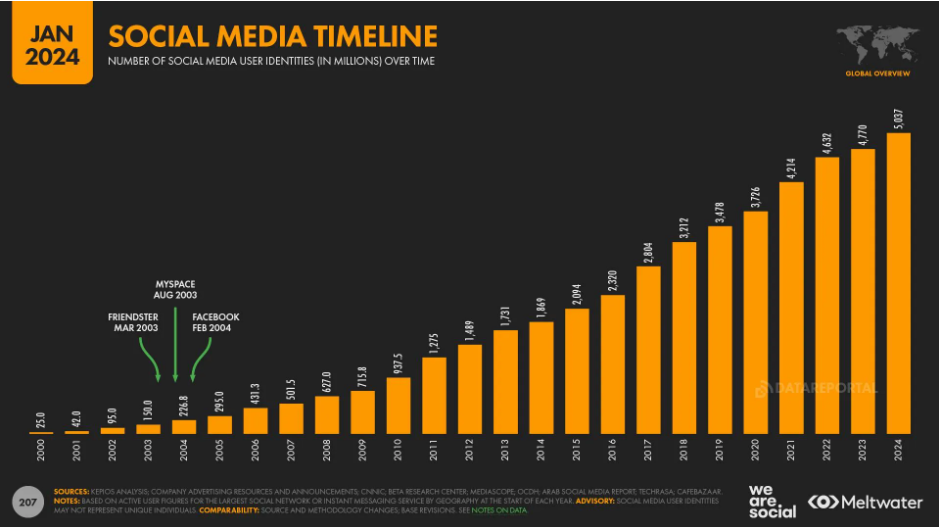MeltWater and WeAreSocial have just released the Digital 2024 Global Overview Report. This is an overview report that provides the latest data on internet and social media users worldwide. The report synthesizes and analyzes big data sources from parties such as Data.ai, GWI, Statista, Ookla, Semrush, Similarweb, GSMA Intelligence, Skai, SocialInsider, Locowise and PPRO.
According to the United Nations World Population Survey (UNWPP), the world now has 8.08 billion people, up 74 million from last year (0.9%). According to the Digital 2024 report, the number of internet and social media users has reached nearly two-thirds of the global population. Specifically, 5.04 billion social media users, or 62.3% of the world's population, are using one or more social networks, up 5.6% from 2023, according to data from Kepios.
The increase in social media users is not a big surprise, as 66% of the world’s population is online, or 5.35 billion people. That’s up 1.8%, or 97 million new internet users, from 2023.

The number of social network users increased over the years with the birth of once-large social networks such as MySpace or Friendster.
However, more than 1/3 of the population is still 'offline' and this is a group of potential users who will soon join the internet community. This 'offline' group is also a potential customer group that internet companies are racing to attract, especially in populous markets such as India with more than 680 million people not connected to the internet, China with 336 million and Indonesia with 93 million 'offline' people. Southeast Asia alone has nearly 1 billion people not connected to the internet.
Notably, the proportion of mobile device users (smartphones account for the majority) will increase by 2.5%, or 138 million smartphone users from 2023, bringing the total number of smartphone users to 5.61 billion by early 2024. Figures released by GSMA Intelligence show that 69.4% of the global population owns at least one mobile device.
73.3% of Vietnam's population uses social networks
The report said that 73.3% of Vietnam's population is using social networks. Vietnam's population is currently recorded at over 99 million people. In particular, the average time Vietnamese users spend on social networks each day is 2 hours and 25 minutes, ranking in the Top 20 in the world.
More than half of internet users in Vietnam use mobile devices at 55.7% compared to 44.3% using computers. Men are more likely to surf the internet on computers than women.
The average time Vietnamese people spend using the internet on mobile phones is 3 hours and 30 minutes per day, and on computers is 2 hours and 47 minutes. Meanwhile, the average time people spend watching content on TV is 2 hours and 21 minutes, after the country with the lowest TV viewing time, Japan (2 hours and 19 minutes).
A notable trend among internet users in Vietnam is giving voice commands to digital assistants, with up to 26.6% using them weekly.
Vietnam's mobile internet speed is 47.06 Mbps, below the global average (48.61 Mbps). However, the mobile network price for 1 GB of internet connection is among the Top 10 cheapest, at an average of 0.29 USD.
The number of Vietnamese people using smartphones to scan QR codes each month is up to 46.9%. However, this level is still far from the global average of 49%, and the market leading the QR Code trend is China at 64.8%.
93% of Vietnamese watch online videos weekly. The median age group watching online videos is 90% higher for both men and women, 14-44 years old. 95.6% of Vietnamese watch streaming content weekly. And 21.7% pay monthly fees for streaming content services or subscription TV.
Vietnamese people prefer watching music over listening to music, as the rate of watching music videos online is 55.1% and listening to music online is 31.6%. In addition, the trend of listening to podcasts that has emerged in recent years continues to be a form of content that attracts internet users. 16.1% of internet users in Vietnam listen to podcasts and on average, Vietnamese people listen to podcasts for 46 minutes per day.
Source link


![[Photo] President Luong Cuong meets 100 typical examples of the Deeds of Kindness Program](https://vstatic.vietnam.vn/vietnam/resource/IMAGE/2025/4/16/ce8300edfa7e4afbb3d6da8f2172d580)
![[Photo] Opening of the Exhibition on Green Growth](https://vstatic.vietnam.vn/vietnam/resource/IMAGE/2025/4/16/253372a4bb6e4138b6f308bc5c63fd51)
![[Photo] President Luong Cuong receives Ethiopian Prime Minister Abiy Ahmed Ali](https://vstatic.vietnam.vn/vietnam/resource/IMAGE/2025/4/16/504685cac833417284c88a786739119c)
![[Photo] Opening of the 4th Summit of the Partnership for Green Growth and the Global Goals](https://vstatic.vietnam.vn/vietnam/resource/IMAGE/2025/4/16/488550ff07ce4cd9b68a2a9572a6e035)
![[Photo] Many practical activities of the 9th Vietnam-China border defense friendship exchange](https://vstatic.vietnam.vn/vietnam/resource/IMAGE/2025/4/16/3016ed3ef51049219574230056ddb741)
![[Photo] National Assembly Chairman Tran Thanh Man meets with Ethiopian Prime Minister Abiy Ahmed Ali](https://vstatic.vietnam.vn/vietnam/resource/IMAGE/2025/4/16/c196dbc1755d46e4ae7b506c5c15be55)




























































































Comment (0)